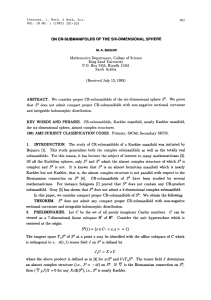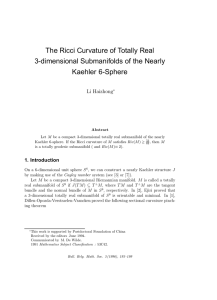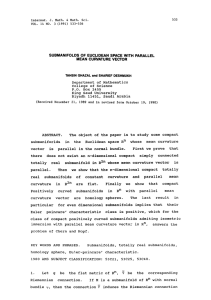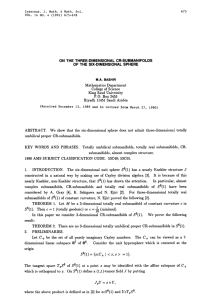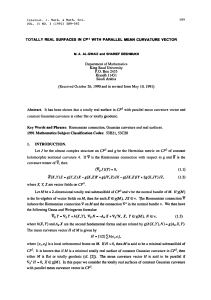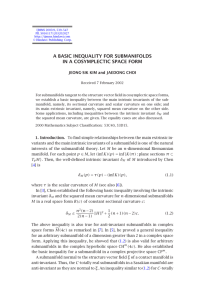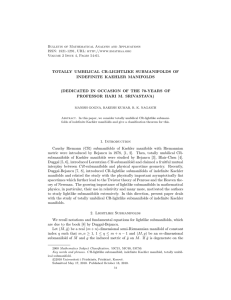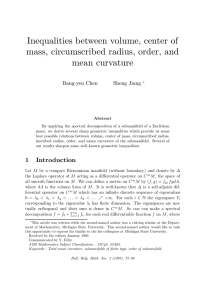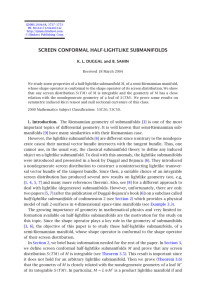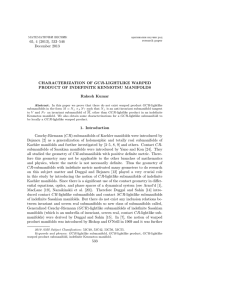Document 10447265
advertisement
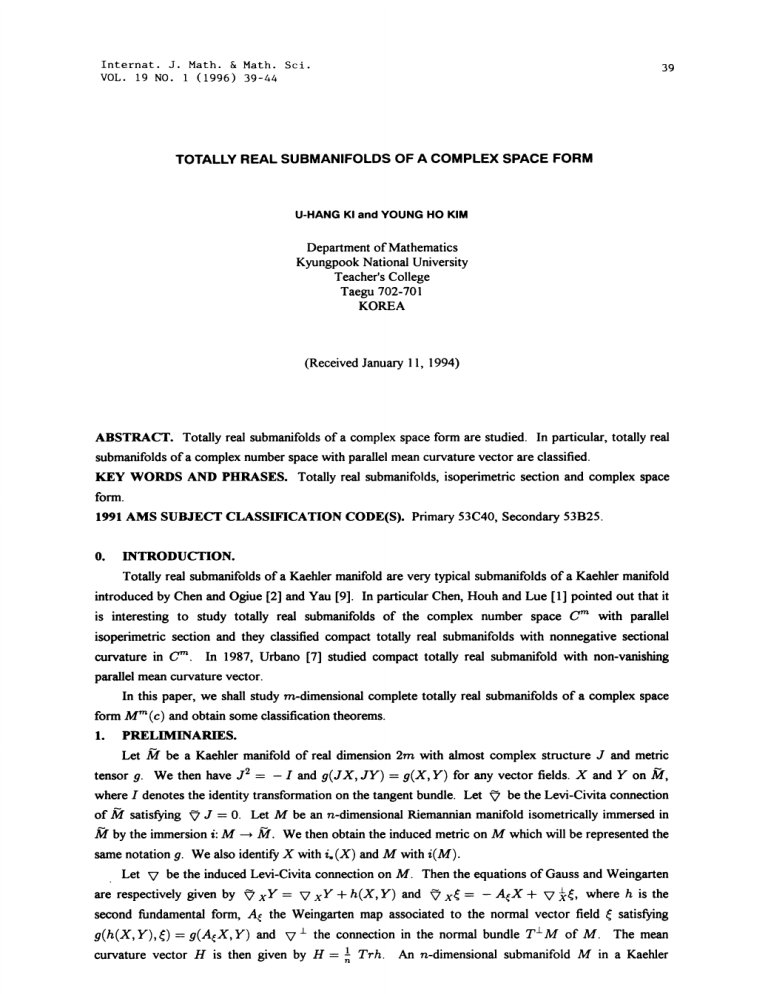
Internat. J. Math. & Math. Sci.
VOL. 19 NO.
(1996) 39-44
39
TOTALLY REAL SUBMANIFOLDS OF A COMPLEX SPACE FORM
U-HANG KI and YOUNG HO KIM
Department of Mathematics
Kyungpook National University
Teacher’s College
Taegu 702-701
KOREA
(Received January 11, 1994)
ABSTRACT. Totally real submanifolds of a complex space form are studied. In particular, totally real
submanifolds of a complex number space with parallel mean curvature vector are classified.
KEY WORDS AND PHRASES. Totally real submanifolds, isoperimetric section and complex space
form.
1991 AMS SUBJECT CLASSIFICATION CODE(S). Primary 53C40, Secondary 53B25.
INTRODUCTION.
Totally real submanifolds of a Kaehler manifold are very typical submanifolds of a Kaehler manifold
introduced by Chen and Ogiue [2] and Yau [9]. In particular Chen, Houh and Lue 1] pointed out that it
is interesting to study totally real submanifolds of the complex number space U with parallel
isoperimetric section and they classified compact totally real submanifolds with nonnegative sectional
curvature in U". In 1987, Urbano [7] studied compact totally real submanifold with non-vanishing
parallel mean curvature vector.
In this paper, we shall study m-dimensional complete totally real submanifolds of a complex space
form M (c) and obtain some classification theorems.
1. PRELIMINARIES.
Let M be a Kaehler manifold of real dimension 2m with almost complex structure and metric
I and g(JX, JY) g(X, Y) for any vector fields. X and Y on/r,
tensor g. We then have j2
be the Levi-Civita connection
where I denotes the identity transformation on the tangent bundle. Let
J O. Let M be an n-dimensional Riemannian manifold isometrically immersed in
of M satisfying
M by the immersion i: M M. We then obtain the induced metric on M which will be represented the
same notation g. We also identify X with i.(X) and M with i(M).
Let
be the induced Levi-Civita connection on M. Then the equations of Gauss and Weingarten
are respectively given by
x Y V x Y + h(X, Y) and
AX + V where h is the
second fundamental form, A the Weingarten map associated to the normal vector field ( satisfying
g(h(X, Y),) g(AX, Y) and 7 +/- the connection in the normal bundle T+/-M of M. The mean
curvature vector H is then given by H 1 Trh. An n-dimensional submanifold M in a Kaehler
0.
-
x
,
40
U. H. KI AND Y. H. KIM
T
manifold//is called totally real if J (Tp M) c M for each P in M, where Tp M is the tangent space
of M at P and T, M the normal space of M at P.
Since J has the maximal rank, m _> n. Let Np(M) be the orthogonal complement of J(TpM) in
Then we get the decomposition
J(TpM) Np(M). It follows that the space Np(M)
is invariant under the action of J.
We now consider an m-dimensional totally real submanifold M of 2m-dimensional Kaehler manifold
M. Then we may set
TM
TM.
JX
O(X),
J
U,
(.1)
(1.2)
.
where X is a vector field tangent to M, 0(X) a normal vector valued 1-form, a normal vector field and
U a vector field on M satisfying g(U, X) g(0(X), ). Applying J to (1. l) and (1.2), we have
X Uo(x) and O(U)
(1.3)
Differentiating (1 1) and (1.2) covariantly and making use of the equations of Gauss and
Weingarten, we get
Uh(X,Y)
o( v xY)
Ao(x)Y,
(1.4)
v i,o(x),
(.5)
,
(1.6)
Uv}
7 xU
O(AX)
h(X, U),
(1.7)
where X and Y are vector fields tangent to M and a vector field normal to M.
We now assume that the ambient manifold M is of constant holomorphic sectional curvature 4c,
which is called a complex space form and it is denoted by M(c). Then the Riemann Christoffel curvature
tensor R of M(c) has the form
gCt(x, )z, w) ((x, w)(, z) (Y, w)(x, z) + (sx, w)(JY, z)
g(JY, W)g(JX, Z) 2g(JX, Y)g(JZ, W)).
Since the manifold M is totally real, it follows from equations(1, l)-(1.7) that the equations of Gauss,
Codazzi and Ricci for M are respectively obtained
g(R(X, Y)Z, W) c(g(X, W)g(Y, Z) g(Y, W)g(X, Z))
(1.$)
+ g(h(X, W), h(Y, Z)) g(h(Y, W), h(X, Z)),
(-xh)(Y, Z)
where
-h(
-
g(R +/- (X, Y),, rt)
(yh)(X, Z),
c(g(O(X), rl)g(O(Y), )
(1.9)
g(O(Y), rt)g(O(X), )
+ g([A, An]X, Y),
is the covariant derivative on
,x Y, Z)-
h(Y,
T(M)T+/-(M)
x Z),R and R
normal bundle respectively and
[A, An]
+/-
defined by (-xh)(Y,Z)=
ch(Y,Z)
are the Riemann curvature tensor of M and that in the
TOTALLY REAL SUBMANIFOLDS OF A COMPLEX SPACE FORM
41
FUNDAMENTAL LEMMAS.
In this section, we assume that M is an m-dimensional totally real submanifold of a complex space
form M(c) of real dimension 2m A normal vector field ( is said to be parallel if 7 -( 0 for any
vector field X on M and ( is called an moperlmemc section if Tr A is non-zero constant
LEMMA 1. Let M be an m-dimensional totally real submanifold of M(c) with parallel
isoperimetric section ( If A has no simple eigenvalues, then M (c) is flat
PROOF. Since A is self-adjoint with respect to g, there exists an orthonormal basis
e,} for TpM such that g(Ae,, e,) A6,3, where A1, )2,
{et, e2,
Am are eigenvalues of A.
Since is parallel, we see that
2.
,
,
g([A, Ao]e,, %)
(, j)g(A,e,, %)
((o(,), )g(O(e), )
for y nodal vector field
e { 1, 2,
m} there is j
because of (1.10).
such that
.,
g(o(), v)(o(,), ))
Since
A
has no simple eigenvues, for each
(g(o(,), )g(o(), )- (o(),,)(o(e,), ))
o.
Choosing q as O(e,), we get cg(O(e,),() 0 By (1 1), we see that {O(e,)
1,2,
,m} fos
onhonofl basis for
It follows that M(c) is flat. (Q.E.D.)
1. Let M be an m-dimensional totally real submanifold of M(c)(c 0). If M has an
isopefimetfic section then A has simple eigenvalues
Let H be the me cuature vector field defined by H
Trh. We now assume that H is
nonvsng pallel in the nodal bundle. We choose an onhonoal am {, 2,
,} in the
nofl bundle in such a way that (1 H/ H
It follows that TrA, 0 for
2, where A, A,
and U, U2,
U fo onhonofl basis for TpM because of (1.2), where U, U,. Then (1.3)
d (1.4) imply
TM.
,
AtU Uh(u,,u,),
(2.1)
wMch shows that
A,U AU,.
Tng the scM product th
d mng use of (1.3), (1.7) and (2.1), we may set
A, Ua #Ua,
(2.2)
k
g(O(AUa), ). Because A, is a setfic operator d h is a syetfic bilin fo,
where #
# is setfic th respect to Ml indices i, j d k.
On the other hd, (2.2) implies
h(u,, u)
O(A,U)
Sin y veor field X on M c be expressed as X
h(X, Y)
.
k
ag(X, U)U, h c be tten by
Pokg(O(X), (,)g(O(Y), (a)k,
(2.3)
which implies
Trh
where Pk
’Pik.
Since 1 is parallel in the
g([A,, A1]X, Y)
-’Pkk,
norma bundle, (1
c(g(O(Y), l)g/(0(X), (,)
(2.4)
0) gives
g(0(X), 1 )g(O(Y),
for all vector fields X and Y on M. (2.5) together with (2.3) yields
(2.5)
U. H. KI AND Y. H. KIM
42
’PkP
(TrA1)Pk
c(m
1)6k
(2.6)
and hence
-’(PI)
where P
(TrAI)P + c(m- 1),
(2.7)
Pll 1.
We now prove
LEMMA 2. Let M be an m-dimensional totally real submanifold of a complex space form M(c)
with nonvanishing parallel mean curvature vector H. Then An is parallel.
PROOF. Let {el,e2,
,) be an orthonormal frame of M(c) at a point P of
,em,l,2,
M such that el,e2,’. ",em are tangent to M and ,2,"" ",(m are normal to M, where
n/ n II. Then we get
ATrA
g(A’A,,A) +
v A,
(2.s)
where A is the Laplacian operator and A’A1 denotes the restricted Laplacian A’ of A1 is given by
(A’A,)X -][R(ei, X),A,]et
(se [6] for detail).
Making use of (1.8) of Gauss ad the fact that M is totally real, we have
A’A1 c(m 1)A c(TrA)(I UI (R) U) + (TrA)’]PijP#Ua (R) Uk
t,j,k
(2.9)
with the help of(2.3), (2.4) and (2.5). If we use (2.5) and (2.6), we obtain
g(A’A1,A1) =0.
(2.10)
X)Uj
AIX EPijg(Ui,
t,j
(2.11)
On the other hand, we can put
because of (2.3). We now extend 1,2,
,m to differentiable orthonormal normal vector fields
defined on a normal neighborhood O of P by parallel translation with respect to normal connection along
geodesics in M. Then we get
V yA1)X
because of (1.6). Therefore,
E( V YPijl)g(Ut, X)Uj at P
(2.12)
A’A1 is reduced to
A’A1 (
V yP31)U, (R) U
i,3
(2.13)
If we use (2.9), then we have
g((A’A)UI, U1)
c(m 1)P + (TrA1)E(/ll )2
E Pt2kPtjl J::k11"
i,3,k
TOTALLY REAL SUBMANIFOLDS OF A COMPLEX SPACE FORM
43
Making use of (2.6), we obtain
9((A’A1)U1,U1) =0.
Thus (2 3) implies
AP
Since
TrA21
,,g(AU,,AU,)= -’,,o(/:’,s)
A(TrA1)
(2.14)
0.
(TrA)P +c(m- 1),
(TrA )AP
we see that
O.
Combining (2.8), (2.10) and the last equation, we get the result (Q.E.D)
3. MAIN THEOREMS.
Let M be an m-dimensional totally real submanifold of a complex space form M(c) with
nonvanishing parallel mean curvature vector. By lemrna 2, we know that AH is parallel. We now define
a function hn for any integer n > 1 by h, Tr(A). Then h, is constant on M for any integer n since
AH is parallel. This implies that each eigenvalue of An is constant on M. Let #1,/2, ",/o be
mutually distinct eigenvalues of AH and hi, r,
no their multiplicities. So the smooth distributions
defined and orthogonal each other.
are
of
all
to
consisting
corresponding
eigenvectors
Ta
#a
Since AH is parallel, Ta are parallel and completely integrable. By the de Rham decomposition
M,, where the tangent
theorem [4], the submanifold M is a product manifold M Mg.
bundle of Ma corresponds to Ta. We now assume that the ambient manifold is fiat, that is, a complex
number space C and M is embedded in C’. Then as in [1] we can choose an orthonormal basis
-, e for TM as eigenvectors of AH and J,J,
e, e,
J for J(TpM) in such a way that
for
0
and
eo E Lu3], e, E ’r],/3 :/= 7, where O] is the
hi hjk ho,, where hs/ o(A4 e,, e) h,,/=
eigenspace corresponding to the eigenvalue
Let 7re(H be the component of H in the subspace C Then 7re(H is a parallel normal section of
Me in C’’e and Me is umbilical with respect to 7re(H ). Therefore, Me is a minimal submanifold of a
x M, embedded in
hypersphere in C"e. Hence M is a product submanifold M1 x M2 x
"1
Thus
C", where Me is a totally real submanifold embedded in some C
C
Cr, C
we have
THEOREM 1. Let M be an m-dimensional complete totally real submanifold embedded in a
complex number space Cm. If M has parallel mean curvature vector H, then M is either a minimal
xM
embedded
in
or
submanifold
a
product
submanifold
MI M2 x
01
’e2
n
C xC x
C
x Cw, where Me is a totally real submanifold embedded in some C
is also a minimal submanifold of a hypersphere of Cve
THEOREM 2. Let M be an m-dimensional complete totally real submanifold embedded in a
complex number space Cr". If M has the nonvanishing parallel mean curvature vector and An has
S 1.
mutually distinct eigenvalues, then M is a product submanifold of circles S x S
is
x
a
Moore
of
lemma
a
M
PROOF. By
product immersion
[5],
Mm
M1 M2
embedded in C’’, and M, is a totally real submanifold in C and contained in a hypersphere in
Sim;e n + rv2 +
+ r, m, r, must be 1. Hence M, S 1, a circle in a complex space C.
,,
.,
’
re.
we.
(Q.E.D.)
U.H. KI AND Y. H. KIM
44
THEOREM 3. Let M be an m-dimensional totally real submanifold of a complex space form
M(c) with nonvanishing parallel mean curvature vector H If An has mutually distinct eigenvalues, then
M is flat.
PROOF. Let el, e2,
respectively. Since An
"era be eigenvectors of An corresponding to eigenvalues A1, A.,
is parallel by Lemma 2, we have
., Am
AH R(X, Y)e, A,R(X, Y)e,
for any vector fields X and Y on M, that is R(X, Y)e, is an eigenvector of AH corresponding to A,.
Taking the inner product with %, we obtain
(A,- A)g(R(X, Y)e,, %)
0
because AH is a symmetric operator. Thus M is flat if AH has mutually distinct cigenvalues. (Q.E.D.)
REMARK. Let M be a totally real submanifold of complex space form M(c) with nonvanishing
parallel mean curvature vector H. Considering Lemma 1, we see that M(c) is flat if the sectional
curvatures defined by principal vectors of H are nonzero.
ACKNOWLEDGEMENT. This work was partially supported by TGRC-KOSEF.
REFERENCES
1.
2.
3.
4.
CHEN, B.-Y., HOUH, C.-S. and LUE, H.-S., Totally real submanifolds, J. Diff. Geom 12
(1977), 473-480.
CHEN, B.-Y. and OG1UE, K., On totally real submanifolds, Trans. Amer. Math. Soc., 193
(1974), 257-266.
KI, U.-H. and NAKAGAWA, H., Compact totally real submanifolds with parallel mean
curvature vector in a complex space form, J. Korean Math. Soc. 23 (1986), 141 150.
KOBAYASHI, S. and NOMIZU, K., Foundations ofDiffernetial Geometry I and II,
Interscience Publishing, New York, 1963 and 1969.
5.
MOORE, J.D., Isometric immersions of Riemannian products, J. Diff. Geom. 5 (1971), 159168.
6.
7.
SMYTH, B., Submanifolds of constant mean curvature, Math. Ann. 205 (1973), 265-280.
URBANO, F., Totally real submanifolds, Geometry and Topology of Submanifolds, World
Scientific, Singapore 1989.
8.
9.
YANO, K. and KON, M., Anti-invariant Submanifolds, Marcel Dekker Inc., 1976.
YAU, S.T., Submanifolds with constant mean curvature, and II, Amer. J. Math. 96 (1974),
346-366; 97 (1975), 76-100.
